
It’s 3 a.m., and your phone buzzes with an email—no subject, no greeting—just “Where’s my update, Sam?” Lovely. That’s your client. Now you’re stuck. If you don’t reply, the client will be upset. But if you get up and send the update, your spouse is going to be mad.
You’re thinking, there must be a better way. And you’re right.
Since 2010, I’ve been managing clients for my software business. I’ve tried all the formal, textbook methods, but here’s the truth: the way you manage your clients is something only you can perfect.
In this article, I’ll share the approach I’ve perfected over the last 14+ years that helped me grow Technext from a two-person team to a team of 60. This method has helped me manage clients, keep my family happy, and keep clients coming back for more.

What Client Management Really Means (From My Hard-Earned Experience)
If you’ve been freelancing for a while or maybe even running an agency, working with real clients on real projects, I’m sure you don’t need the textbook definition of client management.
Sure, the textbook says it’s “the process of managing interactions between clients and organizations,” but that barely scratches the surface. In reality, client management is everything you do to build and maintain a strong, lasting relationship with your clients—one that goes well beyond the project itself.
One big misunderstanding is thinking client management starts when the project begins. The truth? It starts much earlier—back when your client was just a lead or prospect. Why? Because the expectations you set early on will shape your relationship moving forward.
We often see freelancers or agencies being overly polite or overpromising just to land a client. But when it’s time to deliver, they fall short, and that leaves a lasting negative impression. The goal is to achieve client satisfaction, and build loyal customers who will not only come back but will also recommend you as a trusted provider.
So, how do you make that happen? For me, it all comes down to three core principles:
Good Communication
Clear and consistent communication is the backbone of any project. If you don’t keep the client updated, things can quickly fall apart. Keeping them in the loop and making sure they understand each step builds trust. And don’t forget—listening is just as important as talking. When clients feel heard, they trust you more.
Transparency and Trust (Both Ways)
Being open about progress, timelines, and challenges is crucial. Clients hate surprises. But trust works both ways—when clients feel comfortable being honest with you, they’re less likely to micromanage and more likely to let you do your job.
Ownership
Taking ownership means treating the project like it’s yours. Clients respect you when they see you take responsibility for both the wins and the mistakes. It shows that you care about their success as much as they do, and that’s what builds loyalty.
These principles guide my approach to client management, and I break the whole process into three phases: before the project, during the project, and after the project. Let’s dive into each.
Before the Project: Getting Things in Order Before You Start
As I mentioned earlier, client management starts at the lead stage. Your work begins right here. You might be thinking, “But Reza, I’m a freelancer; I get my clients from the marketplace.” The process still applies to you. All the proposals you’re sending or bids you’re placing are essentially prospects. How you handle these potential clients is just as important as managing actual clients.
Managing the Would-Be Clients the Right Way
At the very first stage, you’ll deal with way more leads and prospects than actual clients. This is where your communication starts—you get to know them, understand their project goals, and gather as much information as possible about the client, their industry, and their vision. Then, you match their needs with your expertise and decide if you’re the right fit for the job.
A common mistake is becoming overconfident and overpromising to win over these potential clients. My advice? Don’t do it. It will backfire.
Of course, this isn’t as simple as it sounds. You need a clear process for handling all these steps. It can be your own unique style or you can use lead pipeline software to manage prospects. Having a process makes you more professional. Not only will it leave a strong impression, but it will also increase your chances of landing the project. Here’s how we do it at Technext:
How We Handle Leads and Prospects at Technext
First, we categorize all our leads and prospects into different stages based on their status. For example, we have categories like New Leads, Qualified Leads, Meeting Scheduled, Proposal Sent, and so on.
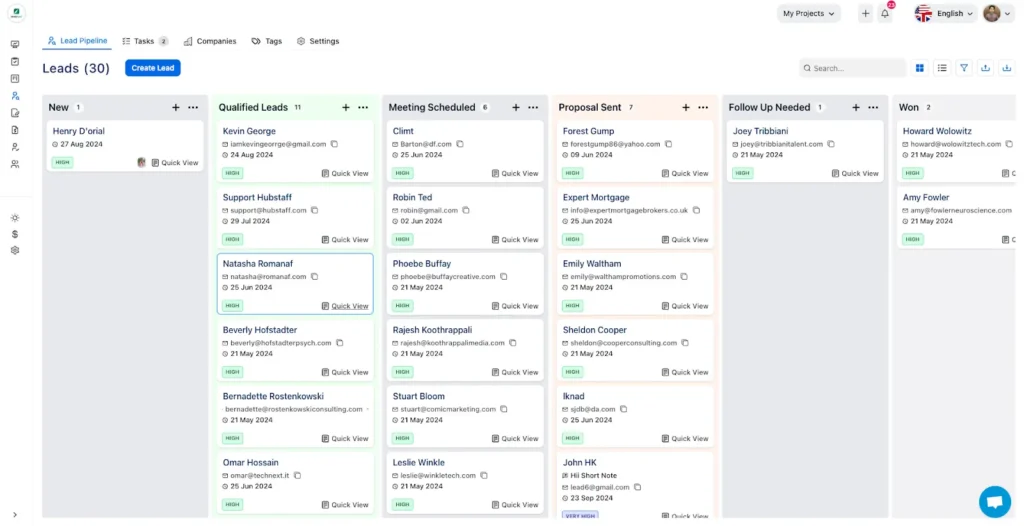
For each lead, we create specific tasks and assign them to the relevant team members. We also set reminders for every task, so nothing slips through the cracks.
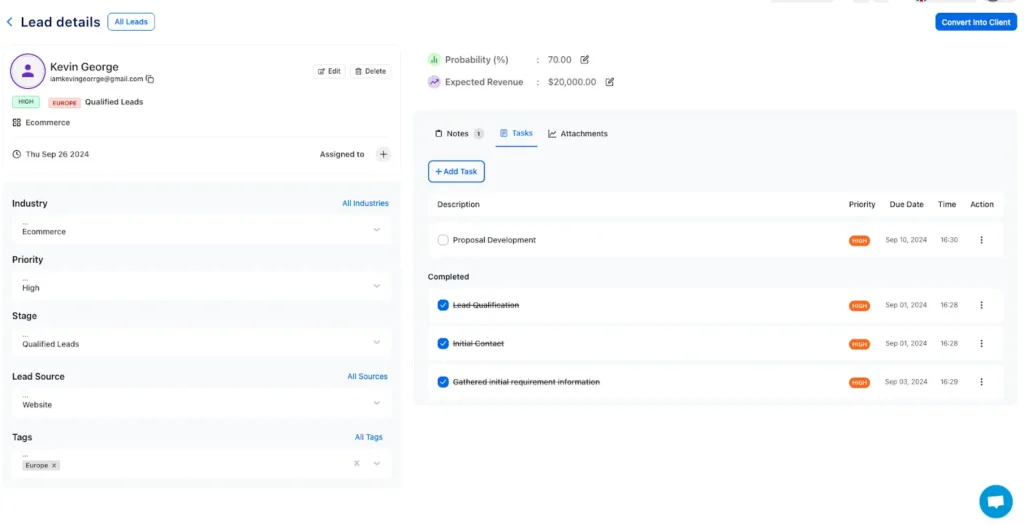
On top of that, we keep all files organized in one place and make sure to take notes on key details throughout the process. This helps us stay on top of everything and ensures that we don’t miss anything important.
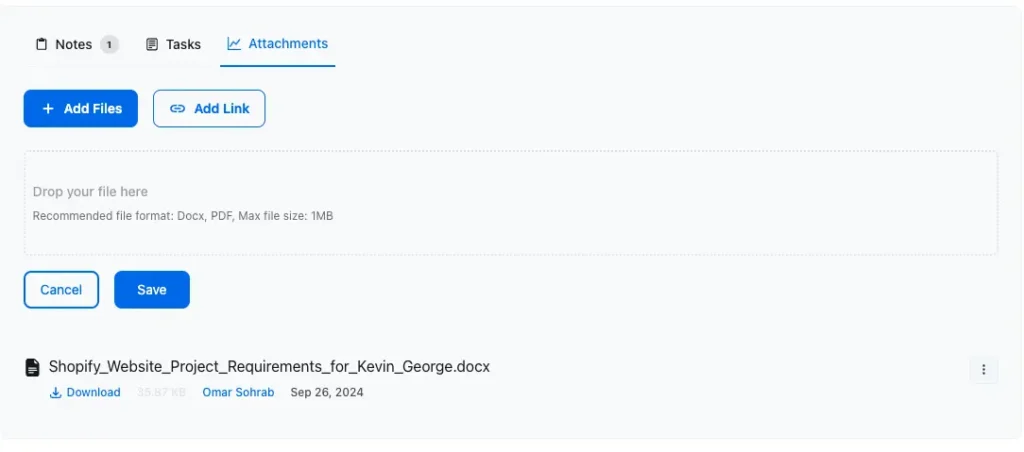
Having this organized system in place allows us to manage our leads efficiently, stay professional, and ultimately increases our chances of winning projects.
Optimize Your Lead-to-Client Conversion with OneSuite
Set Client Expectations
Once you’ve got things moving, one of the biggest challenges is setting the right expectations with your client. You don’t want them expecting more from your product or service than you can realistically deliver. Be upfront and honest, and always aim to under-promise and over-deliver.
Tips for Smart Expectation Setting:
- Be Realistic, Not Optimistic: Stick to what you know you can deliver. Let any extras be a surprise.
- Let Your Client Lead: Ask what results they expect and set realistic timelines based on your experience.
- Document Everything: Keep records of discussions and agreements to avoid misunderstandings and stay aligned.
It’s not about lowering the bar—it’s about building trust, delivering consistently, and exceeding expectations when possible.
Also, Choose the Clients Who Meet Your Expectations
It’s not just about meeting your client’s expectations—it’s equally important that the client meets yours. Before taking on a project, ensure they have the right budget and that their working style aligns with your rhythm.
We’ve all come across clients who are short on budget but promise referrals to friends, family, or even ex-wife in exchange for a discount. Don’t fall for it. These clients tend to be the hardest to satisfy, and the truth is, they rarely ever follow through on their promises of referrals.

Knowing when to say no is key. If you don’t, you’ll end up wasting your time, and the client will end up disappointed. It’s better to walk away from a bad fit than to deal with a tough project that’s not worth the trouble.
During The Project: How to Manage Clients and Stay on Track
Once you start working on a client project, you take on two big roles: 1. Getting the work done, and 2. Managing the client. Both are equally crucial. The great thing is, that you and your client are aiming for the same goal—completing the project successfully. So rather than clashing over changes or requirements, collaborate with them. This approach will naturally enhance client satisfaction. To ensure the rest goes smoothly, here’s what you need to do.
1. Set Up a Client Portal
The first thing you should do is set up a client portal. This will be your client’s go-to spot for updates, files, and progress reports. It cuts down on endless emails and gives your client peace of mind knowing everything they need is in one place. Plus, you can finally sleep through the night without worrying about a 3 a.m. email!
There are plenty of options for setting up a client portal, but you’ll want something easy for your clients to use and smart enough to handle all your projects. Ideally, you want one with a white-label option, so you can add your own domain and make it look like part of your brand.
That’s where OneSuite comes in. It’s designed to give you full control over the client experience and keep communication smooth. If you are looking for something different, here are a few options for client portal software that you may consider.
Create Your Branded Client Portal with OneSuite
Here’s how to make the most of your client portal:
1. Upload Project Milestones
Break the project into clear milestones. This lets your client track progress without needing constant updates. Now they can see what’s done and what’s next.
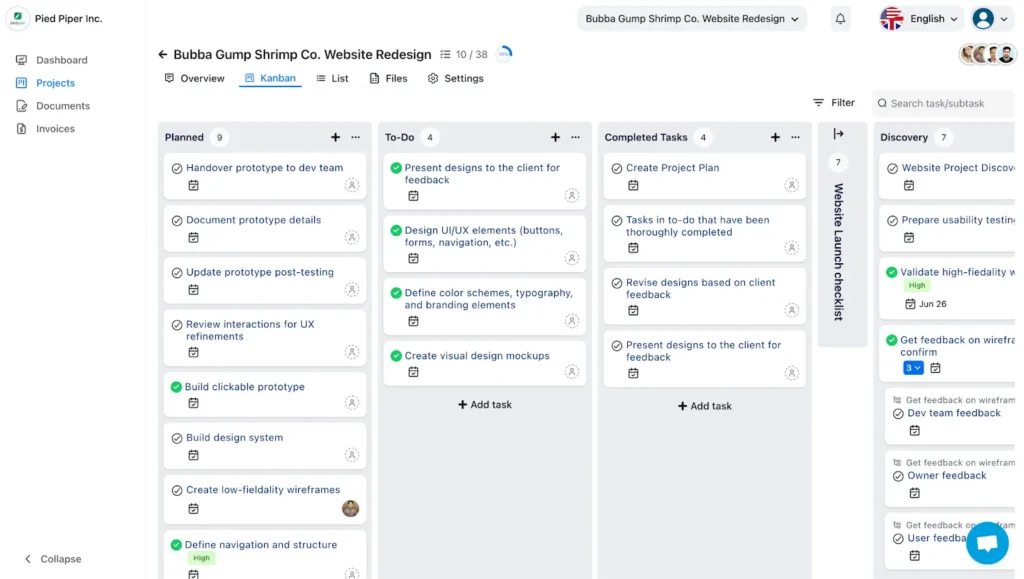
2. Share Important Files
Keep all important documents, proposals, contracts, and deliverables in one place. No more “Can you resend that file?” emails. Everything is ready for them whenever they need it.
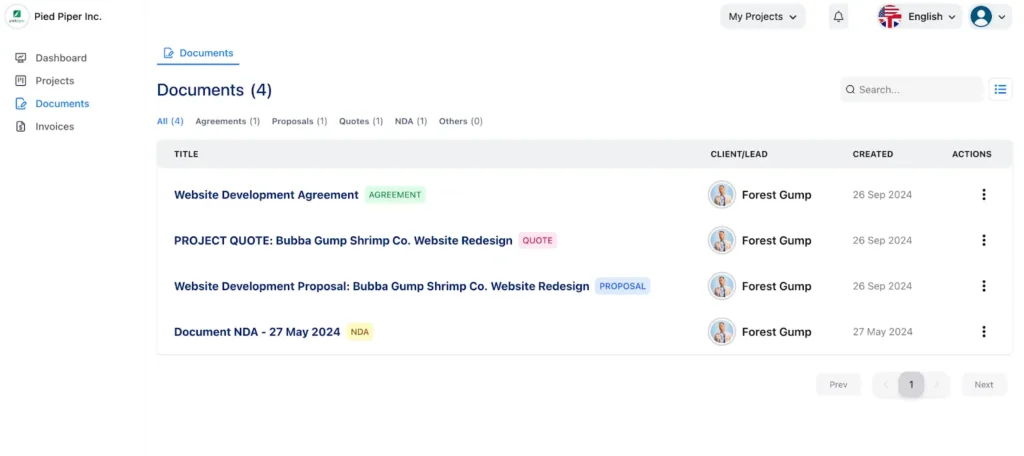
3. Provide Regular Progress Reports
Send regular updates through the portal—weekly or bi-weekly works well. This keeps your client informed and reassures them that things are on track.
2. Make Clients Part of Project Management
Involve your client in the project management, but with clear boundaries. When they’re part of the process, they’ll feel more confident and engaged. But don’t let them micromanage.
Tips for involving clients:
- Share project milestones: Break the project into key milestones and share those with the client. This keeps them aware of progress and helps manage expectations.
- Encourage feedback at key points: Ask for feedback at specific stages of the project. This prevents surprises later and keeps the project aligned with their vision.
- Set boundaries: Make sure they know when and where their input is needed, but also let them trust your expertise. Too much involvement can slow things down, so balance their role carefully.
3. Client Advocacy: Assign a Dedicated Contact
One thing clients really hate is hearing, “I don’t know, ask X.” But it happens, especially in an agency setup. To avoid this, give your client a single point of contact—a dedicated client advocate. This person becomes the go-to for everything, making it easy for the client to reach out and ensuring their concerns are always addressed promptly.
Why it matters:
- Consistent communication: The client advocate will regularly check in, provide updates, and answer any questions. This builds trust and keeps things running smoothly.
- Quick problem-solving: When issues come up, the advocate steps in and handles them quickly, so the client always feels supported.
If you’re a freelancer and managing your clients yourself, don’t worry—you’re already the client advocate! You’re in control of communication, and you can give that personalized attention directly. It’s a win for both sides.
4. Be on Time, Deliver Every Time
Being on time is non-negotiable when it comes to professionalism. Whether it’s for deadlines, meetings, or even small updates, your punctuality speaks volumes. When you manage your time well, you build trust with your client and show them you respect their time as much as your own.
Here’s how to stay on time and deliver every time:
- Set clear, realistic deadlines: Break the project into manageable tasks and set achievable deadlines. Share these with your client so they know what to expect.
- Add buffer time: Always account for unexpected challenges. Extra time ensures you avoid rushing and stay on track.
- Punctuality in all interactions: Be on time for every meeting and update. Regular check-ins help keep everything aligned and prevent surprises.
When you’re on time and deliver consistently, you show clients that you’re reliable and professional—qualities that keep them coming back.
5. Communicate, Communicate, Communicate
If you ask me, the most important factor in client management is communication. It’s what separates the average from the pros. Even if there’s no big update, keeping your client in the loop makes a huge difference. It reassures them that everything’s on track and shows that you’re on top of things.
Here’s how to keep communication smooth:
- Send weekly updates: A quick email summarizing what’s done and what’s coming next is all you need to keep your client informed and feeling confident.
- Respond quickly: Reply to their questions as soon as you can, even if it’s just to say, “Got it.” Fast responses show you’re attentive and help avoid any feelings of neglect.
- Be transparent: If there’s a problem or delay, don’t wait—let them know right away. Being upfront builds trust, even when things don’t go perfectly.
In short, great communication keeps your client happy, reduces stress for both sides and sets you apart from the rest.
6. Adapt to Their Changes
Let’s be honest—mid-project changes can be frustrating for freelancers and service providers. It’s often where most disagreements with clients come from. But think about it—how many times do we make changes when working on our own projects? So, it’s not really fair to expect clients to never request any changes.
That said, it’s also not okay for them to change the entire project halfway through. But if they do, the key is to help them understand the impact without showing frustration.
So, how can you adapt to changes without it hurting your business?
- Assess the impact: When a client asks for changes, figure out how it will affect the timeline, budget, and overall scope. Be honest about what these changes mean.
- Set new deadlines if needed: If changes will take extra time, let the client know and adjust the deadlines right away.
- Adjust the budget if needed: If the changes increase the workload, adjust the project budget as necessary. Just explain why it’s needed.
- Document everything: Keep a clear record of all changes and communicate how they’ll affect the project.
Being flexible with changes is part of the job, but the goal is to make sure the client understands the impact on time, budget, and delivery—without it negatively affecting your business.
7. Follow Up
As I mentioned earlier, one of the key factors in keeping clients happy is keeping them engaged. And the simplest way to do that is through regular follow-ups. When you follow up, you’re not just checking in—you’re showing the client that you’re on top of things and that their project is always moving forward.
Here’s how to nail your follow-ups:
- Regular check-ins: Don’t wait for the client to come to you. Schedule regular check-ins to ensure everything is on track. A quick call or message can prevent any misunderstandings and keeps you both aligned.
- Ask for feedback: At different stages of the project, ask for feedback. This helps you catch any concerns early on and allows you to adjust things before they become bigger issues.
- End-of-project follow-up: Once the project is complete, don’t disappear. Follow up to make sure the client is happy with the results. A satisfied client is more likely to return or refer you to others.
After the Project is Completed: How to End on a Strong Note
Just because your project is finished doesn’t mean the relationship with your client is over. In fact, what you do after the project can be just as important as the work itself. It’s normal to run into a few issues or disagreements while working on a project—that’s part of the process. But how you handle things afterward can fix any rough spots and help build a strong, lasting relationship with your client.
Here’s how to finish things off the right way:
1. Offboarding the Client the Right Way
Once the project is done, make sure you close everything off properly. Deliver the final files, ensure they have access to all documentation or tools, and give them a clear idea of the next steps. The goal is to make sure they’re fully equipped and don’t need to chase you later for anything.
A smooth offboarding leaves a lasting positive impression and shows that you’re organized and professional until the very end.
2. Take a Moment to Celebrate
Take a moment to celebrate the project’s success. A simple “We did it!” or a quick thank you goes a long way. But if you’re working on long-term projects, like we often do, where the whole team is involved, why not throw a small pizza party? Invite the client—even if they join virtually.
Recap the project highlights and make sure to acknowledge the input of every stakeholder, including the client. It’s a great way to remind them that you’re in it for their success, not just the paycheck.
3. Ask for Reviews and Referrals
Don’t miss the chance to ask for a review or testimonial while the project is still fresh in their mind. Politely ask them to share their experience working with you. And while you’re at it, ask for referrals too.
A positive review not only boosts your credibility but can lead to more business. Plus, if there were any concerns, this is your opportunity to address them and improve for future projects.
A simple, “I’d love to hear your feedback and if you know anyone who could benefit from my services,” is all it takes.
Wrapping It Up
So, there you have it—that’s how I manage my clients, from start to finish. It’s a process that’s worked for me over the years, and I hope it gives you the framework to manage your clients more effectively, too. But remember, no one size fits all. Feel free to adjust these steps based on your specific needs, industry, and client relationships.
Client management is a learning process, and what works perfectly for one person might need tweaking for another. Don’t be afraid to experiment and find what fits your workflow best.
If you have any questions or need more insights, don’t hesitate to reach out. We’re here to help you build lasting client relationships and grow your business. Because at the end of the day, happy clients are the key to a thriving business.
Find a Better Way to Grow
OneSuite streamlines projects, clients, and payments in one place, making growth hassle-free.
